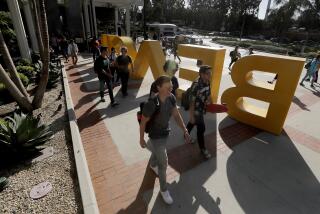Survey offers dire picture of state’s two-year colleges
- Share via
More than 470,000 community college students are beginning the fall semester on waiting lists, unable to get into the courses they need, according to a survey of California’s two-year colleges that captures a system struggling amid severe budget cuts.
The survey, to be released Wednesday, quantified the myriad problems affecting the system, many of which have been anecdotally reported by students on many campuses. The colleges expect steep declines in enrollment and class offerings compared with last fall.
California’s community college system, the nation’s largest, has suffered about $809 million in state funding cuts since 2008. It faces another $338-million hit midyear if voters reject a tax measure on the November ballot supported by Gov. Jerry Brown.
The system has a dual role: It educates students who intend to transfer to four-year schools and it offers job training for others. College officials have been grappling with how to best continue its mission with lower funding but increased demand.
Although they hope for the best, many campuses are planning for the worst. They are taking steps, for example, to negotiate union contracts that include reductions in compensation and employee working hours pending further spending cuts.
“There is no question that the system is shrinking in terms of the number of students we’re serving but not shrinking in terms of demand,” Chancellor Jack Scott said in an interview Tuesday. “The real problem is we don’t have the financial resources to offer the courses that we could fill. In the long run, it’s going to be hurtful to the economy. These are the individuals who are going to make up the future workforce of California.”
These students also tend to be among the neediest: They typically require remedial classes, financial aid, tutoring and counseling. And many are juggling school with jobs.
Yet 70% of colleges in the survey report having reduced hours for such support services, and 87% have reduced staff. In addition, 82% said they planned to offer no winter session this year.
Of California’s 112 two-year colleges, 78 responded to the survey from the chancellor’s office. The colleges represent a cross section of the system, including Yuba College in Marysville, San Joaquin Delta College in Stockton and Santa Monica College.
The colleges predicted a grim year if further cuts are required in January. Administrators said they would need to further reduce class offerings, lay off full-time faculty, postpone building and classroom maintenance, and borrow to manage cash-flow needs.
Already, budget cuts have had a deep effect. Overall enrollment dropped about 17%, from about 2.9 million in the 2008-09 academic year to 2.4 million in 2011-12, and officials have estimated a further decline this year. The number of class sections decreased 24% from 522,727 in 2008-09 to 399,540 in 2011-12.
The colleges say they are being forced to cut into vital services that for many students can mean the difference between success and failure. Nearly 67% of colleges reported that students have had to wait longer for financial aid, counseling and other appointments since 2009-10, with an average wait time of 12 days. West Los Angeles College reported that it had eliminated tutoring and field trips to four-year universities and stopped publishing a student handbook.
El Camino College in Torrance is offering about 1,922 class sections this fall, down from 2,027 last year. Nearly every class has a waiting list, said spokeswoman Ann Garten.
“We have all of these students who want to take courses -- high school graduates, then a whole group who had planned to go to the University of California or Cal State but can’t afford to, and with the economy, all of these people coming back to college because they need skills,” Garten said. But, she said, “we’re all being forced by the state to offer fewer courses for students.”
Nearly 85% of the colleges reported having waiting lists for classes this fall. In all, about 55,000 classes have such lists, the schools reported. The number of students on those rosters averaged 7,157 per campus.
Pasadena City College will offer about 500 fewer sections this fall compared with last year after taking a $6.7-million funding cut, said President Mark Rocha. The campus has been forced to prioritize registration so that students close to graduating or to transferring can get the classes they need. Local high school graduates who are full-time students also have priority.
“It’s the most difficult funding situation I have ever seen for community colleges,” Rocha said. But he said students should not give up hope.
“I see the lines of students, but it’s not impossible,” Rocha said. “No student is being turned away. Can you come and take any course you want any time you want the way you used to? No. But I try to tell students not to be discouraged.”
It’s a tough message to spread. With community colleges having started Monday, students across the system are reporting feeling frustrated and discouraged.
Rogelio Cervantes Jr., for example, said he arrived for a math class this week at East Los Angeles College and found more than 40 students lined up trying to add the already full class.
“You walk through the hallways and it takes five minutes to get from point to point because there are so many students trying to get classes; it’s chaotic,” said Cervantes, 20. He couldn’t get the class times he wanted and was forced to put together a schedule that runs from 8:20 a.m. to 10 p.m. He plans to remain on campus and nap in his car so he doesn’t lose his parking space.
“I’m shooting to graduate next summer,” Cervantes said. “But that’s if I’m able to get all the classes in time.”
--
More to Read
Sign up for Essential California
The most important California stories and recommendations in your inbox every morning.
You may occasionally receive promotional content from the Los Angeles Times.














